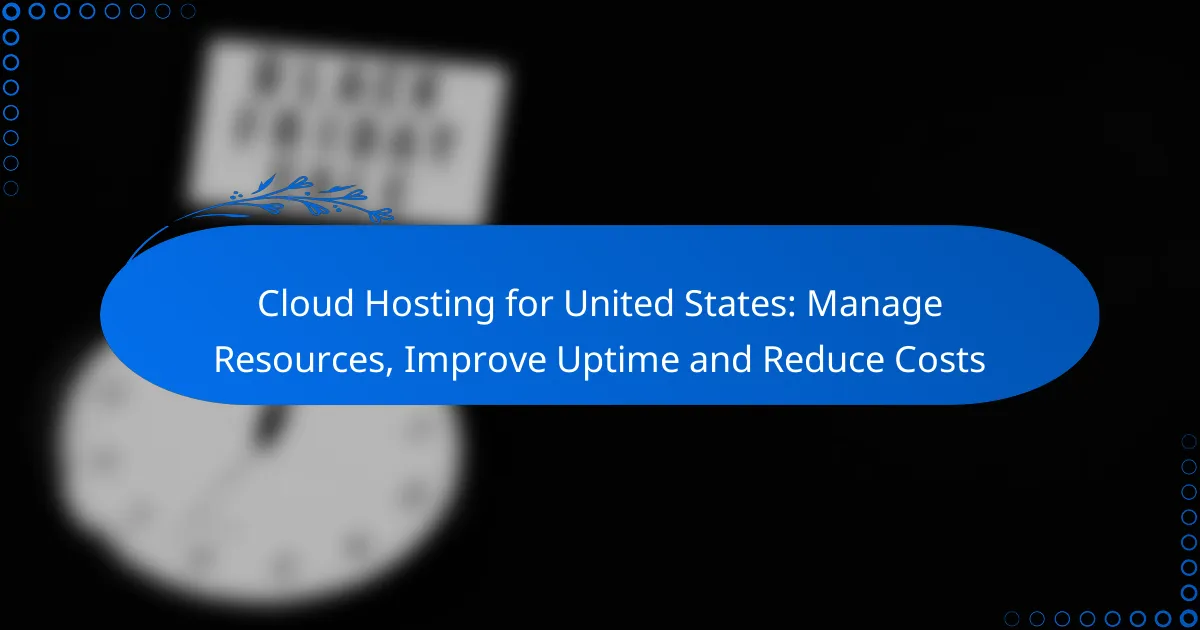Cloud hosting in the United States offers businesses enhanced resource management, improved uptime, and significant cost reductions. Major providers like AWS and Microsoft Azure ensure reliable performance through advanced infrastructure and service level agreements. Understanding pricing models and customer support options is crucial for optimizing your cloud experience and maintaining operational efficiency.

What Are the Key Benefits of Cloud Hosting in the United States?
Cloud hosting provides substantial advantages for businesses in the United States, significantly enhancing operational efficiency. A key benefit is improved uptime, often guaranteed at 99.9% or higher by major providers, ensuring uninterrupted access for users.
With advanced infrastructure and redundancy measures, cloud hosting effectively minimizes downtime. Leading providers like Amazon Web Services and Microsoft Azure utilize multiple geographically dispersed data centers, allowing seamless takeovers within seconds if one fails.
This reliability boosts customer satisfaction and enhances brand reputation, as users expect consistent access. A study reveals that 82% of customers are less likely to return to a website after experiencing downtime, underscoring the importance of uptime in fostering customer loyalty.
Improved uptime
Improved uptime signifies increased availability of cloud-hosted services, crucial for business continuity. Providers typically guarantee uptime percentages around 99.9% or higher, translating to roughly 8.76 hours of downtime annually.
For instance, a business relying on an e-commerce platform benefits from improved uptime, allowing customers to shop without errors or interruptions, which directly boosts sales and retention rates. Research shows that even a 1% increase in uptime can lead to a 10% revenue increase for online retailers.
The implications of improved uptime are significant; businesses operate more efficiently and avoid financial losses from outages, which can average $5,600 per minute for large enterprises, highlighting the necessity of reliable service delivery.
Cost reduction
Cost reduction is a major advantage of cloud hosting, enabling businesses to save on infrastructure and maintenance costs. By utilizing cloud services, companies can sidestep the hefty upfront expenses of physical servers, which can range from $3,000 to $10,000 or more for initial setup.
A startup, for example, can harness cloud hosting to access powerful computing resources without the burden of expensive hardware, often paying as little as $0.01 per hour for virtual machines. This pay-as-you-go model promotes financial efficiency by allowing businesses to pay only for what they use.
Ultimately, the financial flexibility of cloud hosting enhances cash flow management, enabling businesses to allocate resources to critical areas like marketing or product development, fostering overall growth.
Resource management
Resource management in cloud hosting focuses on optimizing computing resources to meet business needs effectively. This includes efficiently managing storage, bandwidth, and processing power, leading to significant cost savings.
For instance, businesses can adjust their resources based on demand, such as during peak shopping seasons, where a 30% increase in resource allocation may be necessary. This dynamic allocation ensures companies utilize resources only when needed, reducing waste and operational costs.
Effective resource management enhances operational efficiency and lowers costs, allowing businesses to concentrate on growth and innovation, ultimately driving competitive advantage in their markets.
Scalability
Scalability is a vital feature of cloud hosting, enabling businesses to adjust resources as needed, accommodating growth or seasonal fluctuations seamlessly. This flexibility is essential for companies facing rapid demand changes.
A media company launching a new product, for example, can quickly scale server capacity by 50% to manage increased traffic, ensuring a smooth user experience. Once demand subsides, they can scale back down, maintaining cost-effectiveness and operational efficiency.
The ability to scale resources seamlessly allows businesses to respond swiftly to market changes, preserving competitiveness and customer satisfaction in today’s fast-paced digital environment.
Enhanced security
Enhanced security is a crucial advantage of cloud hosting, offering robust protection against cyber threats. Cloud providers invest heavily in security measures, including advanced encryption protocols and multi-layered firewalls, ensuring data integrity and confidentiality.
For example, sensitive customer data stored in the cloud is typically encrypted with AES-256 encryption, making unauthorized access extremely difficult. Regular security updates and continuous monitoring further mitigate risks, with many providers offering 24/7 security operations centers.
With enhanced security, businesses can build trust with customers, knowing their data is protected, which is essential in today’s digital landscape, where data breaches can cost companies an average of $3.86 million per incident, emphasizing the need for robust security measures.

How to Choose the Right Cloud Hosting Provider?
Choosing the right cloud hosting provider is vital for enhancing your online presence. A dependable provider ensures effective resource management, maximizes uptime, and minimizes costs. Key factors like service level agreements (SLAs), customer support, and pricing models significantly influence your decision-making process and ultimately affect your business performance.
Service level agreements (SLAs) specify the expected performance and reliability of the hosting service. These agreements typically include uptime guarantees, response times for support requests, and compensation for service outages. A robust SLA safeguards your business against unexpected downtimes and financial losses, with many providers offering compensation clauses that can cover up to 100% of service fees during significant outages.
When assessing SLAs, seek providers that guarantee at least 99.9% uptime, translating to roughly 22 hours of downtime annually. Additionally, examine the penalties for failing to meet these guarantees, as they reveal the provider’s confidence in their service and commitment to reliability.
Service level agreements are crucial for understanding your cloud hosting provider’s commitments. They outline the expected level of service, including uptime, performance, and support response times. A well-defined SLA serves as a benchmark for evaluating reliability, ensuring you have clear expectations and recourse in case of service failures.
For example, a provider may promise 99.99% uptime, equating to only about 4.38 minutes of downtime per month. This reliability is essential for businesses that depend heavily on their online presence, such as e-commerce platforms. Moreover, SLAs should clearly define what constitutes downtime and how it is measured, ensuring transparency in service delivery.
The benefits of a strong SLA include peace of mind for your business operations and potential financial compensation in case of service failures. Always read the fine print to grasp the terms and conditions associated with the SLA, as this knowledge empowers you to make informed decisions about your cloud hosting provider.
Customer support is a critical aspect of cloud hosting that can greatly influence your experience. A provider with robust support options can help you resolve issues swiftly, minimizing downtime and disruption. Look for providers that offer 24/7 support through various channels like phone, email, and live chat, ensuring assistance is available whenever you need it.
For instance, some providers may assign dedicated account managers for enterprise clients, ensuring personalized assistance tailored to your specific needs. Additionally, consider the availability of self-service resources such as knowledge bases and community forums, which can empower you to resolve minor issues independently and enhance your overall support experience.
Effective customer support can lead to improved uptime and a smoother experience in managing your resources. Ensure that the provider’s support options align with your business needs and preferences, as this alignment can significantly impact your operational efficiency and satisfaction.
Pricing models for cloud hosting can vary widely among providers. Understanding these models is crucial for selecting a service that fits your budget while meeting your resource needs. Common pricing structures include pay-as-you-go, subscription-based, and tiered pricing, each catering to different business requirements and usage patterns.
For example, pay-as-you-go models allow you to pay only for the resources you use, making them ideal for businesses with fluctuating demands, such as startups or seasonal retailers. Conversely, subscription-based models offer predictable costs but may require a longer commitment, which can benefit established businesses with stable resource needs. Tiered pricing strikes a balance, offering different service levels at varying price points to accommodate diverse operational scales.
When evaluating pricing, consider not just the base costs but also any additional fees for bandwidth, storage, or support. A transparent pricing model helps you avoid unexpected expenses and make informed decisions about your cloud hosting needs, ensuring you choose a provider that aligns with your financial strategy and operational goals.

What Are the Best Cloud Hosting Providers in the United States?
Cloud hosting in the United States is shaped by several key providers, each offering distinct features and benefits tailored to various business needs. Choosing the right provider can greatly influence your resource management, uptime, and cost efficiency. Leading cloud hosting providers include AWS, Google Cloud Platform, Microsoft Azure, and DigitalOcean, each catering to specific requirements from startups to large enterprises.
AWS, or Amazon Web Services, leads the cloud hosting market with an extensive array of over 200 fully featured services. It delivers scalable computing power, diverse storage options, and robust networking capabilities that evolve with your business. With AWS, users can deploy applications globally, ensuring high availability and reliability—essential for businesses seeking a competitive edge.
Google Cloud Platform (GCP) is celebrated for its powerful data analytics and machine learning capabilities, featuring tools like BigQuery for data insights and TensorFlow for AI development. Its robust infrastructure supports applications from simple websites to complex enterprise solutions. GCP’s seamless integration with other Google services enhances its appeal for businesses already within Google’s ecosystem, positioning it as a strong contender in the cloud space.
Microsoft Azure excels in integrating with Microsoft products and services, making it an ideal choice for businesses using Windows Server, SQL Server, and Office 365. It offers a hybrid cloud solution that allows organizations to effectively manage both on-premises and cloud resources, especially beneficial for those with legacy systems. Azure’s extensive compliance certifications, including ISO 27001 and HIPAA, make it a preferred option for industries with stringent regulatory requirements.
DigitalOcean caters to developers and startups, providing a streamlined cloud experience focused on high-performance virtual machines. Its user-friendly interface and straightforward pricing, starting at just $5 per month, make it accessible for small businesses. DigitalOcean emphasizes reliable performance for web applications and development environments, enabling startups to launch their products quickly and efficiently.
AWS stands out as the most comprehensive cloud platform, offering over 200 fully featured services from data centers worldwide. It provides solutions for computing, storage, databases, machine learning, and analytics, allowing businesses to leverage AWS for everything from hosting websites to running complex applications. The pay-as-you-go pricing model fosters significant cost savings, as businesses only pay for the resources they use—crucial for startups and growing companies managing tight budgets.
With AWS, users benefit from flexible pricing plans, including reserved instances that offer discounts for long-term commitments. This adaptability is vital for businesses aiming to optimize their cloud spending. Additionally, AWS’s global infrastructure, with data centers in 25 geographic regions, ensures high availability and redundancy, significantly reducing downtime risks and enhancing performance for users around the globe.
Google Cloud Platform is renowned for its robust data processing and machine learning capabilities, making it a favorite among data-driven businesses. GCP’s infrastructure is built on the same technology that powers Google’s own products, ensuring reliability and scalability. The platform’s flexible pricing model allows businesses to choose between pay-as-you-go and committed use contracts, optimizing cloud spending while enabling developers to focus on innovation rather than infrastructure management.
GCP places a strong emphasis on security, featuring data encryption and identity management to protect sensitive information. Its global network enhances application performance, making it suitable for businesses with a worldwide customer base. The integration of serverless computing options allows developers to deploy applications without managing servers, streamlining the development process.
Microsoft Azure is a robust cloud platform that seamlessly integrates with Microsoft products, offering flexibility for developers across various programming languages and frameworks. Azure’s hybrid cloud capabilities enable businesses to maintain on-premises infrastructure while leveraging cloud resources, particularly beneficial for organizations transitioning to the cloud. Its competitive pricing structure provides various options to suit different business sizes, ensuring companies can find a plan that meets their needs.
Moreover, Azure’s commitment to compliance and security is evident through its extensive list of certifications, including SOC 1, SOC 2, and GDPR compliance. This makes it a preferred choice for industries such as finance and healthcare, where data security is paramount. Azure’s global presence, with data centers in over 60 regions, allows businesses to deploy applications closer to their users, enhancing performance and reliability.
DigitalOcean is crafted for developers and small businesses, offering an easy-to-use cloud platform that prioritizes simplicity and performance. Its straightforward interface enables users to deploy applications swiftly, making it ideal for startups eager to launch their products without extensive cloud expertise. The platform’s competitive pricing and transparent billing model help businesses manage their budgets effectively while providing various droplet configurations to meet specific needs.
With DigitalOcean, users can scale rapidly as their businesses grow, ensuring their cloud infrastructure keeps pace with increasing demands. Additionally, the vibrant community and extensive documentation available make it easier for developers to find support and resources, fostering a collaborative environment. DigitalOcean’s focus on high-performance virtual machines guarantees smooth application operation, providing a reliable environment for businesses to thrive in the cloud.

How Can Cloud Hosting Improve Resource Management?
Cloud hosting optimizes resource management through automated allocation and real-time insights, leading to performance boosts of up to 30% and cost reductions of 20% or more. This efficiency is vital for businesses striving to stay competitive in a fast-changing digital landscape.
Automated resource allocation
With cloud hosting, businesses can allocate resources dynamically based on demand, allowing for agile responses to fluctuating workloads. For example, during peak times like Black Friday, additional resources can be provisioned automatically, ensuring websites remain operational and responsive even under heavy traffic.
Real-time monitoring tools
This adaptability not only minimizes waste but also maximizes resource utilization, ultimately cutting operational costs by as much as 25% while enhancing service delivery. Consequently, organizations can scale operations confidently, avoiding the pitfalls of overspending or underperformance.

What Are the Cost Factors in Cloud Hosting?
Cloud hosting costs can vary widely, with estimates ranging from $10 to over $1,000 per month, depending on usage and resource needs. Understanding these factors is essential for businesses to manage budgets effectively and avoid overspending.
The primary cost factor is the pricing model selected by the user, which may include pay-as-you-go, reserved instances, or flat-rate pricing. Each model can result in different expenses based on usage patterns, with pay-as-you-go often being ideal for businesses with fluctuating workloads.
For example, some providers implement tiered pricing based on resource allocation, where costs can rise by 20% or more with increased usage. This approach benefits businesses with variable demands, allowing them to adjust resources without committing to a fixed monthly fee.
Moreover, hidden costs such as data transfer fees—typically ranging from $0.05 to $0.15 per GB—and storage expenses can significantly affect overall spending. It’s crucial to assess these factors to avoid unexpected charges that can quickly strain budgets.
Pay-as-you-go pricing
Pay-as-you-go pricing offers flexibility, allowing businesses to pay only for the resources they use, with costs generally between $0.01 and $0.10 per hour for virtual machines. This model is particularly beneficial for startups and small businesses with unpredictable workloads, aligning expenses with actual usage.
For instance, if a company faces a sudden surge in traffic, such as a 300% increase during a promotional event, they can scale resources accordingly without incurring fixed costs. This adaptability can yield substantial savings during off-peak periods, as businesses only pay for what they consume.
However, while pay-as-you-go can lower costs, it necessitates vigilant monitoring of usage to avoid unexpected expense spikes, which can arise if resource consumption goes unchecked. Businesses should implement tracking tools, such as cloud cost management software, to effectively manage resource consumption and maintain budget control.



